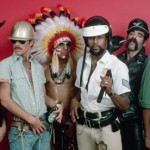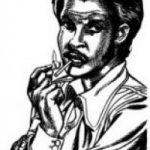Hooven, Valentine. 1997. Tom of Finland: his life and times. New York: St Martin’s Press.
One thing I’ve been curious about in the life of Touko Laaksonen, better known the world over as Tom of Finland, is did he participate in BDSM?
Hooven’s 1993 biography explores the deeply closeted, all-male, outdoors world that formed Laaksonen’s sexuality. There were a handful of bars and cafes in 1940s and 1950s Finland that catered to gay men, but they upheld a culture of effeminacy he didn’t care for. (Hooven makes the point that the “queen” stereotype was a way of asserting gay identity publicly in decades past.) His way to be gay was to partake in furtive, anonymous, nighttime encounters in parks, bus stations and the like.
In the 2017 Tom of Finland biopic, Laaksonen connects with an underground of gay men who held house parties for wearing leather or uniforms, but Hooven’s book makes no mention of these.
His distinctive artwork is full of inhumanly handsome men in uniform, rendered in minute detail, or leather, each fold and highlight carefully drawn. Yet only a minority of them show bondage or flagellation. The image reproduced on page 31, of a man in full SS dress uniform beating another, bound man, appears to be an exception, not the rule. He often took commissions, so we should be careful not to take every illustration as a direct product of his own imagination and tastes.
Laaksonen’s love of men in uniform, even fascist uniforms, raises many complicated questions about separating the politics of fascism from the aesthetics of fascism. In his own words:
In my drawings I have no political statement to make, no ideology. I am thinking only about the picture itself. The whole Nazi philosophy, the racism and all that, is hateful to me, but of course I drew them anyway — they had the sexiest uniforms.
[Pg.30]
It seems that Laaksonen’s sexual imagination went no further than leather as fashion statement, though he was ahead of the curve:
Since the fifties, when really tough guys wore the black-leather uniform of the alienated loner, leather has been one of the great fashion trends of the twentieth century. By the nineties, everyone wore it, even young matrons taking their kids to the pediatrician. But Tom was into leather in the forties. This was so early that, while the postwar rebel without a cause had already come into existence, he had not yet discovered black leather; he was still wearing brown.
[Pg.50]
Again, in Laaksonen’s own words:
Before and during the Second World War, what leather clothing there was, was always brown. Suddenly, right about 1950, the black biker’s ‘uniform’ appeared. It is amazing how fast it spread around the world. I have been told that I influenced its birth, but the truth is that I copied the biker’s leathers, the caps, and [the] engineer boots from English and American photographs.
[Pg.115]



